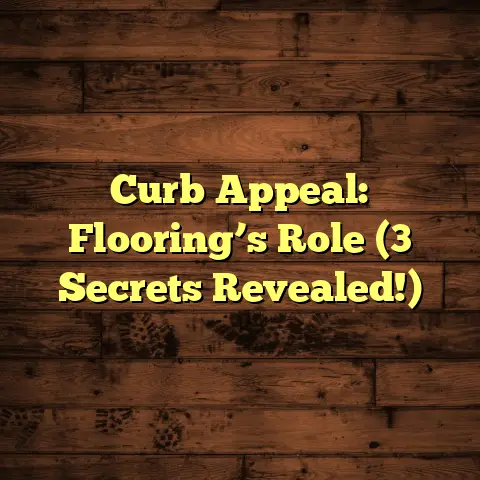Remove Laminate Under Skirting (DIY Guide?)
But sometimes, life throws us curveballs. Maybe you’ve got some water damage under the skirting, are tackling a renovation, or simply want to upgrade your flooring. Whatever the reason, you’re probably here because you need to remove laminate from under your skirting boards.
Don’t worry, I’m here to guide you through the process. It’s a manageable DIY project with the right tools and a little patience. We’ll cover everything from prepping the area to the satisfying feeling of a job well done.
Section 1: Understanding the Basics
What is Laminate Flooring?
Laminate flooring is a multi-layer synthetic flooring product fused together through a lamination process. It mimics the look of real wood, tile, or stone at a fraction of the cost.
It’s made up of several layers:
-
Wear Layer: This is the top, transparent layer that protects against scratches, stains, and fading.
-
Decorative Layer: This is the printed image that gives the laminate its wood, tile, or stone look.
-
Core Layer: This is the heart of the laminate, usually made of high-density fiberboard (HDF) or medium-density fiberboard (MDF). It provides stability and impact resistance.
-
Backing Layer: This bottom layer provides moisture resistance and helps prevent warping.
Laminate’s popularity stems from its affordability, aesthetic versatility, and ease of installation. Many homeowners choose it for its wood-like appearance without the hefty price tag of hardwood. Plus, it’s relatively easy to install yourself, saving on professional installation costs.
Common Laminate Flooring Issues
Even though laminate is durable, it’s not invincible. I’ve seen my fair share of problems over the years. Here are some common issues:
-
Water Damage: This is the big one. Laminate is water-resistant, not waterproof. Spills need to be cleaned up quickly, and excessive moisture can cause swelling, warping, and delamination.
-
Wear and Tear: Over time, the wear layer can get scratched or worn down, especially in high-traffic areas.
-
Gaps: Temperature and humidity changes can cause laminate planks to expand and contract, leading to gaps between the boards.
-
Need for Removal: Sometimes, the damage is too extensive to repair, or you simply want to upgrade to a different type of flooring. That’s where we come in!
The Role of Skirting Boards
Skirting boards (also called baseboards) are those decorative strips that run along the bottom of your walls. They serve several purposes:
-
Aesthetic Appeal: They add a finished look to the room, covering the gap between the wall and the floor.
-
Protection: They protect the wall from scuffs and bumps from furniture and foot traffic.
-
Hiding Imperfections: They conceal any unevenness or gaps between the wall and the flooring.
When laminate flooring is installed, it’s usually placed under the skirting boards. This creates a clean, seamless look. However, it also means that removing the laminate often requires removing the skirting first.
Section 2: Tools and Materials Needed
Alright, let’s get down to the nitty-gritty. Before you start tearing things up, you’ll need to gather the right tools and materials. Here’s what I recommend:
-
Pry Bar: This is your best friend for gently removing skirting boards. A flat pry bar or a small molding pry bar works well. You can find these at any hardware store for around \$10-\$20.
-
Utility Knife: This is essential for scoring along the top of the skirting board where it meets the wall. This helps prevent the paint from peeling when you remove the skirting. A good utility knife with replaceable blades will cost you around \$15-\$25.
-
Hammer: You’ll need this to tap the pry bar behind the skirting and to gently tap the skirting back into place if you’re reinstalling it. Any standard hammer will do, costing around \$10-\$30.
-
Screwdriver: Depending on how your skirting is attached, you might need a screwdriver to remove screws. Have both a Phillips head and a flathead on hand. A multi-bit screwdriver set is a great investment for around \$20-\$40.
-
Safety Goggles and Gloves: Safety first! Protect your eyes and hands from flying debris and sharp edges. Safety goggles cost around \$5-\$10, and work gloves are about the same.
-
Dust Mask: Removing flooring can create a lot of dust. A dust mask will protect your lungs. A basic dust mask is very inexpensive, costing only a few dollars.
-
Optional but Recommended:
-
Multi-Tool with a Saw Blade: This can be incredibly useful for cutting the laminate around door frames or other tight spots. A decent multi-tool will set you back around \$50-\$150.
-
Stud Finder: If you’re planning to reinstall the skirting, a stud finder will help you locate the wall studs for secure attachment. A basic stud finder costs around \$15-\$30.
-
Caulk and Caulk Gun: For sealing gaps between the skirting and the wall after reinstallation. Caulk is cheap, around \$5 a tube, and a caulk gun costs about \$10-\$20.
-
Replacement Skirting Boards: If your existing skirting is damaged or you want a different style. Prices vary depending on the material and style, but expect to pay around \$5-\$15 per linear foot.
-
Adhesive: Construction adhesive for reattaching skirting boards. A tube of adhesive costs around \$5-\$10.
-
Underlayment: If you’re replacing the laminate, you’ll likely need new underlayment. Prices vary depending on the type, but expect to pay around \$0.50-\$2 per square foot.
-
You can find all of these items at your local hardware store, home improvement center, or online retailers like Amazon or Home Depot.
Section 3: Preparing the Area
Okay, you’ve got your tools, now let’s get the room ready for demolition… I mean, removal.
-
Clear the Room: The first step is to remove all furniture, rugs, and anything else that might get in your way. Trust me, you’ll appreciate the extra space to maneuver.
-
Clean the Area: Sweep or vacuum the floor to remove any loose debris. This will prevent you from grinding dirt into the subfloor when you’re removing the laminate.
-
Take Measurements: If you’re planning to replace the flooring or skirting, now’s the time to take measurements. This will save you a headache later when you’re trying to figure out how much material you need.
-
Safety First: Put on your safety goggles, gloves, and dust mask. It’s better to be safe than sorry.
-
Ventilation: Open windows or turn on a fan to ensure adequate ventilation. This will help reduce the amount of dust in the air.
Section 4: Step-by-Step Guide to Removing Laminate
Alright, here’s the moment you’ve been waiting for: the actual removal process. Take your time, be patient, and don’t be afraid to ask for help if you get stuck.
Step 1: Removing the Skirting Boards
This is often the trickiest part, but with the right technique, it’s manageable.
-
Score the Top Edge: Use your utility knife to score along the top edge of the skirting board where it meets the wall. This will help prevent the paint from peeling off the wall when you remove the skirting.
-
Insert the Pry Bar: Gently insert the pry bar between the skirting board and the wall. Start at one end of the board.
-
Pry Carefully: Gently pry the skirting board away from the wall. Work your way along the board, prying a little at a time. If you encounter resistance, try moving to a different spot along the board.
-
Identify Fasteners: As you pry, look for nails or screws that are holding the skirting in place. If you find nails, try to pry around them to avoid damaging the skirting. If you find screws, remove them with your screwdriver.
-
Remove the Skirting: Once you’ve worked your way along the entire board, it should come loose. Carefully remove it from the wall.
-
Repeat: Repeat this process for all of the skirting boards in the room.
Pro Tip: If the skirting boards are really stuck, try using a thin piece of wood or cardboard to protect the wall from the pry bar. This will help prevent damage to the drywall.
Step 2: Removing the Laminate Flooring
Now that the skirting is out of the way, you can finally get to the laminate.
-
Start at the Edge: Begin at the edge of the room where the laminate meets the wall.
-
Lift the First Plank: Use your pry bar or a flathead screwdriver to gently lift the first plank. You might need to wiggle it a bit to loosen it.
-
Work Your Way Across: Once you’ve lifted the first plank, you should be able to slide it out. Continue working your way across the room, lifting and removing each plank.
-
Be Careful Around Edges: Pay close attention to the edges of the room, especially around door frames and other obstacles. You might need to use your multi-tool to cut the laminate to size.
-
Avoid Subfloor Damage: Be careful not to damage the subfloor as you remove the laminate. If you’re having trouble lifting a plank, try using a hammer and a block of wood to gently tap it from underneath.
Pro Tip: Laminate flooring is often installed with a “click-lock” system. This means that the planks interlock with each other. To remove the planks, you might need to gently tap them in the opposite direction of the locking mechanism.
Step 3: Cleaning Up
You’ve removed the laminate and the skirting! You’re almost there. But before you celebrate, you need to clean up the mess.
-
Dispose of Old Laminate: Properly dispose of the old laminate flooring. Check with your local waste management company for guidelines on how to dispose of construction debris. Many areas have specific regulations about this.
-
Remove Debris: Sweep or vacuum the area to remove any remaining debris, such as dust, nails, or staples.
-
Check the Subfloor: Carefully inspect the subfloor for any signs of moisture or damage. If you find any problems, address them before installing new flooring.
-
Remove Old Adhesive: Scrape off any old adhesive or caulk from the walls and subfloor. A putty knife or scraper will come in handy for this.
Pro Tip: Consider renting a shop vacuum with a HEPA filter for a more thorough cleanup. This will help remove even the smallest particles of dust and debris.
Section 5: What to Do After Removal
You’ve successfully removed the laminate and cleaned up the area. Now what?
-
Inspect the Subfloor: As I mentioned before, it’s crucial to inspect the subfloor for any signs of moisture or damage. Look for:
-
Water Stains: These indicate that water has been leaking into the subfloor.
-
Mold or Mildew: This is a sign of excessive moisture.
-
Rotting Wood: This indicates that the subfloor has been damaged by water.
-
Unevenness: This can cause problems with your new flooring.
If you find any of these problems, you’ll need to address them before installing new flooring. This might involve repairing or replacing sections of the subfloor.
-
-
Install New Flooring or Reattach Skirting:
-
Installing New Laminate: If you’re installing new laminate flooring, follow the manufacturer’s instructions carefully. Be sure to use a proper underlayment to provide cushioning and moisture protection.
-
Reattaching Skirting Boards: If you’re reattaching the existing skirting boards, use construction adhesive and nails to secure them to the wall. Be sure to align them properly and fill any gaps with caulk.
-
-
Ensuring a Seamless Transition:
-
Trim: Use trim pieces to create a smooth transition between the flooring and the skirting.
-
Caulk: Apply a bead of caulk along the top edge of the skirting to seal any gaps and create a clean, finished look.
-
Pro Tip: When reinstalling skirting boards, use a stud finder to locate the wall studs. This will ensure that the skirting is securely attached to the wall.
Conclusion
Removing laminate under skirting boards might seem daunting, but it’s a manageable DIY project with the right tools and a little patience. By following these steps, you can save money on professional installation costs and enjoy the satisfaction of a job well done.
Remember, careful planning and execution are key to success. Take your time, be patient, and don’t be afraid to ask for help if you get stuck. And most importantly, have fun!





